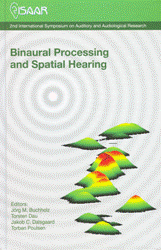A binaural auditory model and applications to spatial sound evaluation
Abstract
Reproduced sound quality is in uenced by many perceptual factors such as sound source direction and distance, timbre, loudness, spatial impression, and temporal characteristics. Listening tests can be performed to assess these aspects, but computational auditory models provide an interesting alternative to the direct use of human subjects. While this model-based approach is commonly used for monaural audio evaluation, the application of advanced binaural models to spatial sound evaluation remains a challenge. In this paper, we present a binaural auditory model based on the two principles of interaural cross-correlation and binaural cue selection and we illustrate how it can be utilized in two different spatial sound applications.
References
Atal, B. S., Hill, M., and Schroeder, M. R. (1966). “Apparent Sound Source Translator,” U.S. Patent 3236949.
Bernstein, L. R., van de Par, S., and Trahiotis, C. (1999). “”The normalized interaural correlation accounting for NoSπ thresholds with Gaussian and ”low noise” masking noise,” J. Acoust. Soc. Am. 106, 870 – 876.
Faller, C., and Merimaa, J. (2004). “Source localization in complex listening situations: Selection of binaural cues based on interaural coherence,” J. Acoust. Soc. Am. 116, 3075 – 3089.
Huopaniemi, J., and Smith, J. O. (1999). “Spectral and time-domain preprocessing and the choice of modeling error criteria for binaural digital lters,” in 16th Intl. Convention of the Audio Eng. Soc. (Rovaniemi, Finland, April 10-12, 1999). pp. 301–312.
Huopaniemi, J., Zacharov, N., and Karjalainen, M. (1999). “Objective and Subjective Evaluation of Head-Related Transfer Function Design,” J. Audio Eng. Soc. 47, 218 – 239.
Jeffress, L. A. (1948). “A place theory of sound localization,” J. Comp. Physiol. Psychol. 61, 468 – 486.
Kirkeby, O., Seppälä, E., Kärkkäinen, A., Kärkkäinen, L., and Huttunen, T. (1999). “Some Effects of The Torso on Head-Related Transfer Functions,” in 122nd AES Convention (Vienna, Austria, May 2007).
Moore, B. C. J., Glasberg, B. R., and Baer, T. (1997). “A Model for the Prediction of Thresholds, Loudness and Partial Loudness,” J. Audio Eng. Soc. 45, 224 – 240.
Pulkki, V., Karjalainen, M., and Huopaniemi, J. (1999). “Analyzing Virtual Sound Source Attributes Using a Binaural Auditory Model,” J. Audio Eng. Soc. 47, 203 – 217.
Slaney, M. (1998). “Auditory Toolbox: Version 2,” Apple Technical Report #1998- 010.
Zwicker, E., and Fastl, H. (1999). Psychoacoustics, Facts and Models (Springer- Verlag, Germany). Second Updated ed.
Additional Files
Published
How to Cite
Issue
Section
License
Authors who publish with this journal agree to the following terms:
a. Authors retain copyright* and grant the journal right of first publication with the work simultaneously licensed under a Creative Commons Attribution License that allows others to share the work with an acknowledgement of the work's authorship and initial publication in this journal.
b. Authors are able to enter into separate, additional contractual arrangements for the non-exclusive distribution of the journal's published version of the work (e.g., post it to an institutional repository or publish it in a book), with an acknowledgement of its initial publication in this journal.
c. Authors are permitted and encouraged to post their work online (e.g., in institutional repositories or on their website) prior to and during the submission process, as it can lead to productive exchanges, as well as earlier and greater citation of published work (See The Effect of Open Access).
*From the 2017 issue onward. The Danavox Jubilee Foundation owns the copyright of all articles published in the 1969-2015 issues. However, authors are still allowed to share the work with an acknowledgement of the work's authorship and initial publication in this journal.


